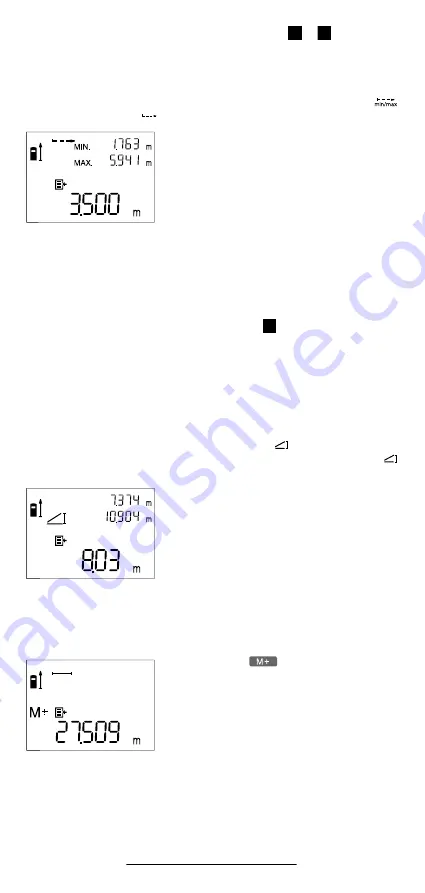
American English–9
1 609 929 E86 • (02.12) T
Minimum-Maximum Measurement (see Fig.
+
)
The minimum/maximum measurement serves to determine the minimum
or maximum distance from a fixed reference point. It is an aid, for exam-
ple, for the determination of diagonals (maximum value) as well as verti-
cals and horizontals (minimum value).
To switch to the minimum/maximum measuring mode, press the
button
1
. The symbol
appears in the display.
To initiate the measurement process, press
the measurement button
7
completely down.
Move the laser point back and forth over the
desired target point (e.g., the corner of a
room) so that the rear end of the unit as the
reference point for the measurement remains
at the same position.
At the upper right in the display, the minimum
and maximum are shown.
By pressing the measurement button
7
, the minimum/maximum mea-
surement is interrupted. The current measured values are shown in the
display. Renewed pressing of the measurement button
7
starts the min-
imum/maximum measurement anew.
Indirect Length Measurement (see Fig.
)
The indirect length measuring function serves for measuring distances
that cannot be measured directly because an obstacle would obstruct the
laser beam or no target surface is available as a reflector. The best pos-
sible results are achieved only when the laser beam and the measured
distance form an exact right angle (Pythagorean theorem).
In the illustrated example, the length
“C”
is to be determined. For this pur-
pose,
“A”
and
“B”
must be measured.
Press the indirect length measurement button
13
to switch to the
mode for indirect length measuring. The symbol for indirect measuring
appears in the display.
As for a length measurement, measure the
distance
“A”
. Take care that a right angle ex-
ists between the laser beam and the distance
“C”
. Then measure distance
“B”
.
During the measurements, the rear end of the
unit as the reference point must remain at the
same position.
After completing the second measurement, the length
“C”
is automatical-
ly calculated and indicated at the bottom of the display. The individual val-
ues are shown at the upper right.
Storing/Adding of Measured Values
By pressing the
button
16
, the value at
the bottom of the display – either a length,
area or volume value depending on the cur-
rent measuring function – is stored in memory.
In the display,
“M+”
appears briefly and then
“M”
.
If a value is already present in the memory, the
new value is added to the memory contents,
however, only when the units of the measure-
ments are in agreement.
For example, if an area value is stored in the memory and the current mea-
surement is a volume value, the addition cannot be performed. In the dis-
play, the “ERROR” message blinks briefly.
D
E
F


































